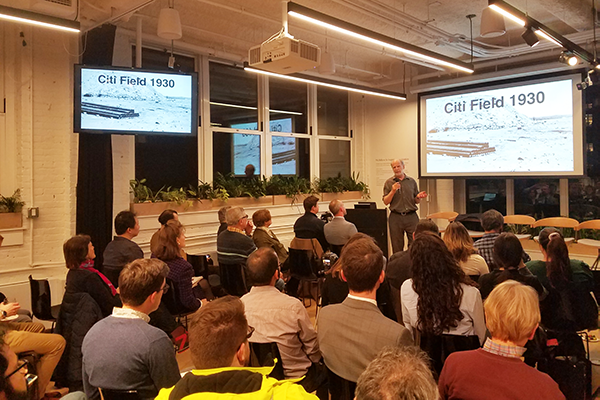
Original publication by Urban Green Council • February 27, 2019
Our Demystifying Steam report tackles pressing questions about the state of steam heat systems in New York City, and how they can be improved to save money for owners and tenants, reduce emissions, and increase comfort. At the report’s launch event, the authors discussed key findings from our research and answered the audience’s questions regarding how, when and why we should invest wisely in our steam heat systems.
The report’s suggested improvements are cost-effective and could reduce heating and hot water expenses by 20 percent—with distribution improvements typically responsible for two-thirds of these savings. We also found that for New York City to continue to reduce building emissions, improvements to steam heat must be implemented now. If all buildings larger than 5,000 square feet pursued the distribution system upgrades in addition to boiler replacements, citywide building-based carbon emissions could be reduced by over 7 percent.
Our engaged audience asked so many great questions that we decided to share some highlights below.
1. Would you recommend steam for new construction or major renovation?
In short, Steven Winter Associates steam system expert Jonathan Flothow said, “heck no!” According to Sean Brennan (Urban Green Council), steam is not going away on its own. Case in point: New York City audit data shows that 30 new buildings installed steam heat since 2000. Demystifying Steam recommends that we future-proof new buildings by evaluating regulations to prohibit new steam heat installations.
2. What programs are available through NYSERDA and/or the Retrofit Accelerator to help our coop renovate our steam distribution system?
The Better Steam Heat Program, which is part of NYC’s Retrofit Accelerator, connects building owners with energy efficiency advisors to determine the best retrofit pathway for their building’s steam heat system. National Grid and Con Edison also offer one-pipe and two-pipe steam incentive programs that encourage owners to make steam retrofits.
Larry Katz (NYC Retrofit Accelerator), said that steam retrofit adoption is ramping up, but we need continued education and marketing of steam heat system upgrades to encourage owners to retrofit their buildings.
3. What stands in the way of downsizing boilers in multifamily buildings?
There are many benefits to downsizing boilers at the time of natural equipment replacement. But downsizing requires advanced planning and education because owners and installers commonly upsize or make like-for-like replacements. This planning is impossible to do when a boiler breaks down and requires emergency replacement. Owners need to be incentivized to plan for their eventual boiler replacements and boiler installers need to be trained to appropriately size that replacement to overcome this challenge.
4. Should we really replace an end-of-life boiler today even if it may be incompatible with future carbon reduction mandates?
Laurie Kerr (LK POLICY LAB) stressed that the perfect can’t be the enemy of the good. There is no one-size-fits-all solution, so we need a layered approach where we pursue each opportunity to reduce emissions. This report is not recommending replacing functioning boilers but recommends implementing a suite of best practices at the end of a boiler’s useful life.
Additionally, Kerr is hopeful that successful and cost-effective hydronic conversions could be available in the future. Jonathan Flothow explained that once you convert a building to hydronic heat, it is easier to electrify in the future and the boiler can still be used as a backup. A backup boiler enables owners to install smaller, less expensive and more energy-efficient heat pump equipment. To study this further, Urban Green’s current electrification research is digging into the possibilities of bridge technologies to help smooth the transition from our existing heating infrastructure to low-carbon heating systems.
5. When should we stop installing new boilers in favor of electric systems in order to meet 80×50?
Mike Brusic (Bright Power) took off his moderator cap to share his perspective on this question, replying “yesterday.” Brennan added that if we assume a boiler’s lifespan is about 30 years, we have to stop installing new boilers right now. But because there are no market-ready cost-effective alternatives, that’s not possible.
Demystifying Steam sets 2030 as the milestone for building owners to begin pursuing non-fossil fuel heating technologies. Each building will need a plan for eventually transitioning away from fossil fuels, but carbon saved today is more helpful than carbon saved tomorrow since cumulative emissions are the real problem. Over the next decade, a building that improves its steam heat would avoid carbon emissions equivalent to shutting down the boiler for two years!
6. Are orifice plates really the answer to the age-old problem of steam trap maintenance?
Orifice plates can be installed on two-pipe steam radiators to ensure warmth without overheating. During installation, each radiator should receive a tag stating that it has an orifice plate installed and listing the size of its hole. These plates require no maintenance and can eliminate the need for almost all steam traps, which notoriously fail within 5 years and are a hassle to replace.
However, steam traps are better than orifice plates on the topmost floors of buildings with oversized boilers and risers that are difficult to access. Oversized boilers quickly push air through riser vents and make loud hissing sounds when the heat starts up. If a boiler is too large and causes noise in riser vents, then top-floor steam traps are a reasonable option. But the traps must be diligently monitored and replaced at fixed intervals.
Further Reading
Demystifying Steam: Smaller Buildings
Our predictive model sheds light on steam use in smaller multifamily buildings and where to focus on upgrades in the city.
Waste Heat Energy Recovery Technologies
Learn about waste heat recovery and the state-of-the-art technologies that are available to help you optimize energy use in your building!